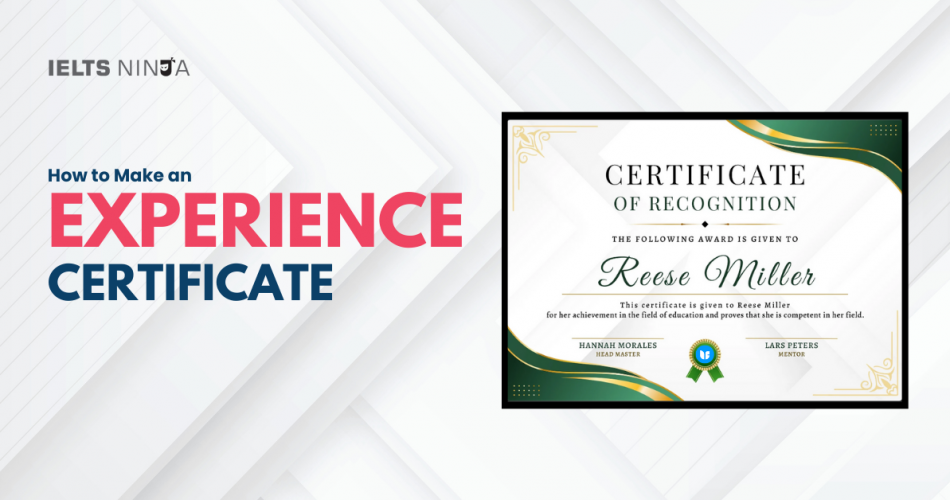An experience certificate is a crucial document that validates an individual’s work tenure and responsibilities within an organization. Whether you’re an employer or an employee, understanding how to create a well-structured and professional experience certificate is essential. In this article, we will provide a step-by-step guide on how to make an experience certificate that effectively showcases an individual’s employment history and contributions.
यह भी पढ़ें: कनाडा पीआर के लिए कितना आईईएलटीएस स्कोर आवश्यक है? उस स्कोर को कैसे प्राप्त करें?
अनुभव प्रमाण पत्र कैसे बनाये?
Step 1: Gather Necessary Information
Before you begin crafting the experience certificate, gather all the pertinent information. This includes the employee’s full name, designation, employment start and end dates, department, and reporting manager’s details. Also, list down the key responsibilities and achievements during the employee’s tenure.
Step 2: Choose a Template or Format
Selecting an appropriate template or format is essential for creating a visually appealing and organized experience certificate. You can find numerous templates online, or you can create your own using word processing software. Ensure that the template aligns with your company’s branding and is easy to read.
Step 3: Include Company Information
Begin the certificate by mentioning the company’s name, logo, address, and contact details. This establishes the authenticity of the document.
Step 4: Mention Employee Details
Next, provide the employee’s full name, designation, and department. Include the specific employment period, starting from the join date to the last working day.
Step 5: Describe Roles and Responsibilities
Detail the key responsibilities and tasks that the employee handled during their tenure. Use clear and concise language to describe their contributions, achievements, and any notable projects they were involved in. Highlight how their efforts positively impacted the organization.
Step 6: Highlight Achievements
If the employee achieved any milestones, targets, or exceptional results, be sure to mention them in the certificate. These achievements not only reflect the employee’s capabilities but also enhance the overall value of the certificate.
Step 7: Include Reporting Manager’s Comments
It’s a good practice to include a brief comment or feedback from the employee’s reporting manager. This adds a personal touch and further validates the employee’s performance.
Step 8: State Reason for Departure
Incorporate a statement about the reason for the employee’s departure, whether it’s due to resignation, completion of a project, contract expiration, or any other reason. This helps provide context for the employment period.
Step 9: Signatures and Seal
Include the signatures of the authorized personnel, such as the company’s HR manager or higher management. This lends authenticity to the certificate. Optionally, you can also include the company’s seal for added credibility.
Step 10: Review and Finalize
Thoroughly proofread the experience certificate to ensure there are no grammatical errors, inaccuracies, or typos. Confirm that all the details mentioned in the certificate are accurate and well-presented.
यह भी पढ़ें: स्थायी निवास को अनलॉक करना: अध्ययन के बाद भारतीय छात्रों के लिए ऑस्ट्रेलिया में पीआर कैसे प्राप्त करें?
Types of Experience Certificate
Experience certificates can take various forms based on the nature of employment and the industry. Here are some common types:
Employment Experience Certificate: This is the most common type of experience certificate, provided by employers to employees who have worked for a specific duration. It details the employee’s job role, responsibilities, accomplishments, and tenure.
Internship Experience Certificate: Given to individuals who complete an internship, this certificate outlines the tasks performed, skills gained, and projects worked on during the internship period. It’s valuable for students and young professionals looking to build their careers.
Project Experience Certificate: For contract-based or project-based work, this certificate focuses on the employee’s contribution to a particular project. It highlights their role, achievements, and impact on the project’s success.
Apprenticeship Experience Certificate: Similar to internships, apprenticeships involve hands-on training in a specific trade. The certificate emphasizes the skills acquired and the level of expertise reached by the apprentice.
Teaching Experience Certificate: Typically provided to educators, this certificate highlights the duration of teaching, subjects taught, and any noteworthy achievements or contributions to the educational institution.
Resignation Experience Certificate: Issued when an employee leaves the organization voluntarily, this certificate acknowledges their service and provides a summary of their contributions. It’s a formal way to mark the end of their tenure.
Contract Experience Certificate: When an individual works on a fixed-term contract, this certificate outlines the contract period, job role, and key responsibilities. It’s important for contract workers to have evidence of their work experience.
Volunteer Experience Certificate: Often provided by nonprofit organizations or community groups, this certificate validates an individual’s volunteer work and the positive impact they’ve had on a cause.
Transfer Experience Certificate: Given when an employee is transferred within the organization, this certificate acknowledges their time and contributions in their previous role before transitioning to a new one.
Industrial Training Experience Certificate: Pertinent in technical or vocational fields, this certificate is provided to individuals who undergo hands-on training in industries to gain practical skills and experience.
Medical Internship Experience Certificate: Specific to medical professionals, this certificate outlines the intern’s exposure to different medical fields, procedures observed, and skills acquired during their internship in a hospital or clinic.
Research Experience Certificate: Issued to researchers and scholars, this certificate details their research contributions, projects, and findings during their time at a research institution or university.
Each type of experience certificate serves a distinct purpose, highlighting the specific experience gained in that context. Tailoring the certificate to the nature of the experience ensures that it accurately reflects the individual’s skills, knowledge, and accomplishments in that particular domain.
यह भी पढ़ें: आपको कनाडा वीज़ा और प्रकार के बारे में जानने की ज़रूरत है: यहां कनाडा विज़िटर वीज़ा, छात्र वीज़ा और बहुत कुछ है!
Experience Certificate Format
Here’s the format of the experience certificate.
[Company Logo]
[Company Name]
[Company Address]
[City, State, ZIP]
[Company Phone Number]
[Company Website]
**Experience Certificate**
This is to certify that [Employee’s Full Name], [Employee’s Designation], was employed with [Company Name] from [Start Date] to [End Date].
During their tenure, [Employee’s First Name] demonstrated exceptional [mention key qualities/skills] and made significant contributions to the organization. Their dedication, commitment, and hard work were evident in [mention specific accomplishments or projects].
**Key Responsibilities:**
– [List of key responsibilities and duties]
– [More responsibilities]
– [And so on…]
**Achievements:**
– [List of notable achievements]
– [More achievements]
– [And so on…]
We appreciate [Employee’s First Name]’s valuable contributions to our team and their role in [mention any company milestones or achievements].
[Employee’s First Name]’s departure from [Company Name] is due to [mention reason for departure, e.g., pursuing new opportunities, completion of contract, etc.].
We wish [Employee’s First Name] continued success in their future endeavors.
Date: [Date of Issuance]
Authorized Signature: ______________________
[Name of Signatory]
[Designation]
[Company Name]
[Company Seal]
निष्कर्ष: Crafting an experience certificate requires attention to detail and a clear understanding of the employee’s contributions. By following this step-by-step guide, you can create a comprehensive and professional certificate that reflects the employee’s journey within the organization. An effectively crafted experience certificate not only serves as a testament to an individual’s skills and dedication but also contributes to a positive employer-employee relationship. Let’s grab the information and get wonderful mentorships from the आईईएलटीएस निंजा वेबसाइट।








